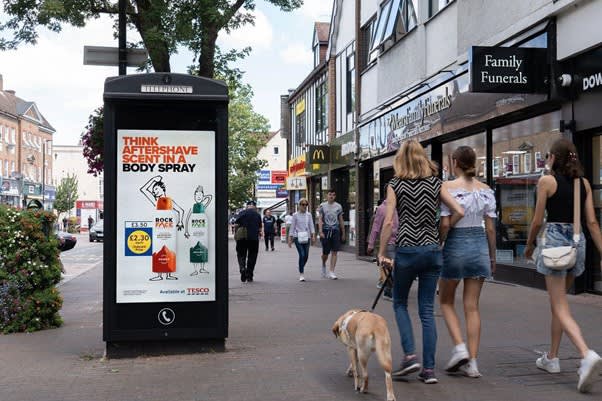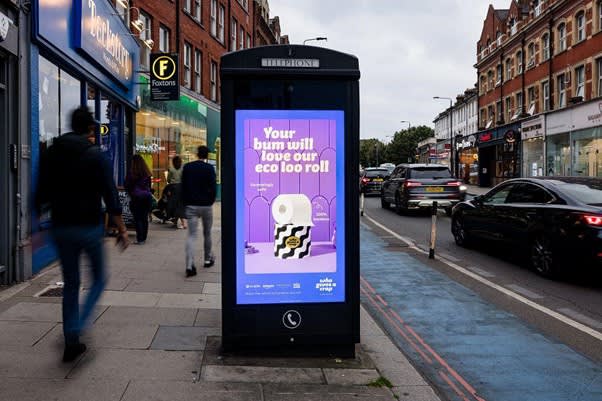Street advertising has long been a feature of public spaces up and down the country. However, fears over the future of the high street might lead some to wonder what that means for one of the most enduring forms of retail advertising.
But retailers need not fear – far from dying, the high street is undergoing a renaissance, as we’ll explain later in this blog. First, let’s take a look at what street advertising is and the many different forms it comes in.
What is street advertising?
Street advertising or high street advertising is a form of marketing where brands place advertising materials such as billboards and posters along roadsides and other public spaces. It’s essentially interchangeable with Out of Home (OOH) advertising but, in certain contexts, might refer specifically to advertising on high streets.
We’ve already mentioned billboards and posters, but the term street advertising encompasses plenty of other types of outdoor advertising. It covers rail advertising, Digital Out of Home (DOOH) formats, and can also include guerrilla marketing tactics, such as stickers placed in public spaces and other forms of outdoor advertising that don’t align with formal OOH methods.
What is street furniture advertising?
Street furniture advertising is very similar but not identical to street advertising. It’s more specific; referring solely to the placement of advertisements on street furniture. Street furniture is what we call objects that have been installed along roadsides for public use or infrastructure.
Street furniture includes items such as traffic lights, post boxes, telephone boxes, litter bins, benches, taxi stands, public transport signage and pretty much anything else you can think of that’s a permanent pavement fixture.
However, street furniture advertising isn’t usually placed on objects like traffic lights, as this could cause distraction for drivers. Instead, you’ll most commonly find it on bus shelters, phone boxes, and purpose-built advertising boards.
Types of street advertising
Street advertising comes in both digital and static forms, offering a variety of flexible options for brands. The most common types of street advertising available in the UK today are:
Murals and street art
Street advertising examples
We’ve put together some recent examples of street advertising campaigns that showcase the variety of brands that can benefit from the medium.

Rockface
Men’s toiletries brand Rockface ran their campaign using repurposed high street telephone boxes. The brand wanted to bring attention to their range of body sprays, achieving this goal with a fun graphic and bold text. By highlighting the product’s availability at local Tesco stores and offering a special Clubcard price, the advert also shows how brands can drive loyalty in retail advertising.

GoPro
Iconic camera brand GoPro is famous for its action-ready cameras, and the brand played into this reputation with a Christmas campaign creative of a young girl enjoying winter sports. The accompanying CTA, encouraging passing audiences to ‘give the gift of fun’, was backed up with the information that the product was available to buy at nearby Argos stores.

Who Gives a Crap
Cheeky toilet roll brand Who Gives a Crap used high street advertising to run a simple but effective campaign promoting their eco-friendly toilet paper. With an eye-catching colour scheme and messaging that highlights the benefits for both the user and the planet, it’s a masterclass in driving home your brand’s USPs.
Benefits of advertising on the high street
High street advertising is one of the most effective ways for brands to communicate their messages to the right people, whether through a highly targeted local campaign or a large-scale national one. Here are some of the key benefits of advertising on the high street.
Reach diverse audiences
There are few environments that attract such demographic diversity as the high street. Whether to run errands, travel to work or meet friends for coffee, all sorts of people pass through their local high street every day, providing endless opportunities for advertisers to reach varied audiences.
Increased visibility
High streets are integrated with daily life – these bustling stretches have constant foot traffic that provides a quick route to increased visibility for brands. And with around 10 million people living within 200 metres of a high street, regular exposure is a given – which further reinforces brand awareness.
Brand differentiation
Capturing attention and driving engagement is extraordinarily difficult in today’s crowded landscape, but street advertising can provide a much-needed way to cut through the noise. The online world is heavily saturated, but in real-life environments, where there are fewer brands competing, it’s easier to stand out from the crowd and form a meaningful connection.
Immediate activation
Modern high streets are vibrant public spaces that are home to all sorts of retailers, from big-brand supermarkets to independent boutiques and coffee shops. With location-based advertising placed in close proximity to their real-world premises, these businesses can capitalise on the flow of foot traffic and prompt consumers into taking immediate action.
The future of the high street
The future of the high street is often discussed and has naturally left some people wondering whether high street advertising is still worth it. For years, the argument has been that the high street is dying – and yet here it is still, with retail stalwarts like John Lewis arguing that such predictions are overstated, as they report falls in online shopping while store visits are up 8%.
In fact, many now believe that the high street is undergoing a renaissance. A Statista survey found that 39% of respondents believed their local high street improved in 2023 due to the variety of shops increasing, while 27% thought that fewer empty shops was the leading reason for improvement.
There are multiple factors driving this high street revolution. People are placing more emphasis on supporting their local communities, as well as shopping locally to reduce their carbon footprint. Young people are increasingly foregoing learning to drive, which means they’re spending more time on high streets where bus routes regularly pass through.
But whatever the reasons may be, one thing is for sure: the high street is most definitely not dead.
To find out more about advertising on the high street, please get in touch and one of our outdoor advertising experts will be able to answer any questions that you have.
It’s as easy as that!
Looking to discuss Out of Home advertising in your local area? Please give us a call or fill in our form and we will get back to you shortly.



.jpg)